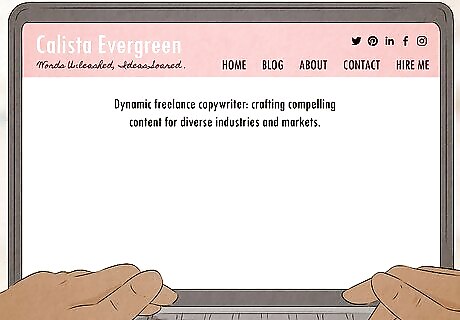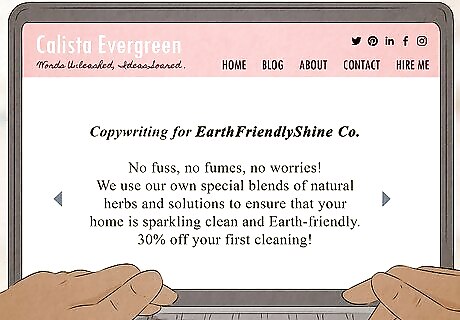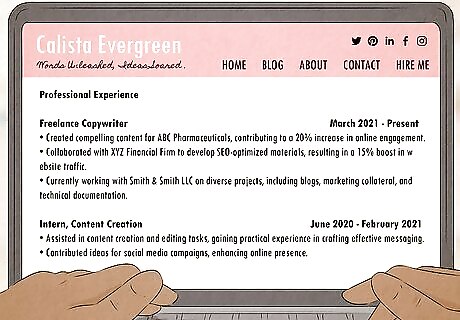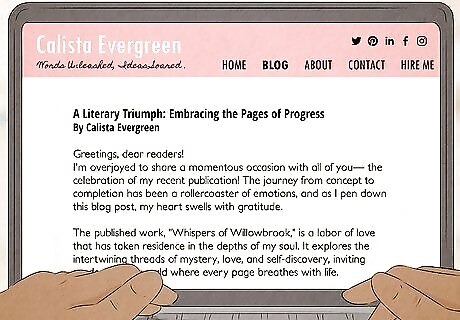
views
Creating Your Freelance Writer Profile

Begin with a 1-2 sentence summary of your skills & services. Mention your background and “niche,” a.k.a., your area of expertise. Place your summary at the top of your profile. Potential clients will quickly scan this text before reading the rest of your profile, so be sure to make it clear and succinct. Write in abbreviated sentences, or write a “list” using the | or • symbol. Example summaries: Video game journalist with 3+ years experience covering gaming industry and culture. Available for breaking news, product reviews, commentary, and features. Video game journalist | 3+ years experience | Expert in Gaming Industry & Culture | Breaking News, Product Reviews, Features, & Commentary

Write a short intro discussing your experience in detail. Make your intro paragraph 3-4 sentences long. Begin by stating your job and niche, then discuss your writing experience and services you offer. List outlets where your work has been published, or describe the kinds of clients you usually work with. Write in third-person to convey a formal tone, or use first-person for a more personal touch. Use the following examples to create your intro paragraph: Make your intro concise and straightforward. This makes it easy for clients to determine if you have the skills and background they’re looking for. Choose the proper perspective and tone for the kinds of clients you want to attract. Write in the third-person to sound more formal if you want to create content for companies or news websites. Example: Maria Miller is a freelance copywriter with 2 years of experience creating content for commercial websites. She has a proven track record of creating engaging, high-quality content on a wide range of topics for marketing, SEO, technical documentation, blogs, and social media. Her previous clients have included ABC Pharmaceuticals, XYZ Financial Firm, and Smith & Smith LLC. Use the first-person if you want to write op-eds, narrative stories, or other content written from your perspective. Example: I am a fashion writer and recent graduate of FIT, where I studied fashion merchandising and wrote for the campus newspaper. I have written product reviews, op-eds, and feature-length stories on industry events in the NYC metro area. In addition to writing for FIT’s student paper, I maintain the fashion news blog “Fashion XYZ” on Medium, which has over 2500 monthly readers.

Provide a list of services you offer. Services can include topics you write about, or specific types of writing such as copywriting, ghostwriting, journalism, translation, etc. Choose services that you know you’d be able to provide. For each service, use keywords to help your services stand out to prospective clients. Then add 1-2 sentences explaining that service. For example, if you’re a technical writer with a background in finance, you might create the following list: Financial Writing. I am available to write about money, budgeting, accounting, investing, credit, and other financial topics. Formats can include blog posts, news articles, marketing materials, and technical documentation, among others. Technical Writing. I am adept at creating concise, detailed technical documents on a variety of financial topics. These may include technical manuals, summaries of research papers, internal company documentation, and more. Marketing Copywriting. I have a proven track record of creating engaging, informative content for marketing campaigns, websites, and company blogs. Search Engine Optimization (SEO). I am available to edit existing web content or write new content to improve search rankings and maximize user engagement. I also provide SEO for social media, including X (formerly Twitter), Facebook, and Linkedin.

Add a portfolio with 3-5 samples of your best work. Choose writing samples that demonstrate your skills, expertise, and unique style. Include a link to each piece of work, followed by a brief description of the work. If a piece of work is not found online, upload a copy to a cloud hosting platform like Google Drive or Amazon Cloud Drive, then provide a link to the document. Your writing samples can include: Articles, essays, op-eds, or other writing published under your name on third-party websites, including news sites, popular blogs, and student publications. Be sure to only include content from family-friendly websites. Content written for third parties that’s not published under your name. This could include material written for company websites, marketing campaigns, newsletters, and social media posts. A personal blog with an established readership. Avoid sharing your blog if it contains personal information, or if its content may be considered inappropriate or unprofessional. Content you’ve copyedited or proofread for a client. Content written for Search Engine Optimization (SEO). Books, magazines, or other print publications where your work has appeared. Note: If the content you want to share isn’t found online, or isn’t publicly visible, contact the company to request permission to feature a copy of the content in your portfolio.

List relevant employment history. This can include jobs, internships, or other roles that are related to your writing. For example, if you’re a copyeditor, list any media internships, editorial jobs, or paid writing positions you’ve held. If you specialize in writing about education, include any teaching or tutoring positions you’ve held. Feel free to include unrelated employment that may reflect favorably on you, including prestigious internships, military service, or volunteer work.

List your education, certifications, & other relevant experience. Include college and other post-secondary degrees. If you obtained certifications in technical writing, copywriting, translation, or other relevant skills, include those too. For example: If you’re a bilingual writer who specializes in Chinese-American culture, mention your B.A. in Chinese history or your certificate demonstrating business-level proficiency in Mandarin. For example: If you mainly write about veterans’ issues, mention your military experience, including any awards or special recognition you received.

Include positive testimonials from previous clients. If you’ve received positive feedback from clients, ask them to write a brief review of your services or work. Then paste that review under a “Testimonials” section. If you haven’t received positive feedback or haven’t worked with clients before, skip this step for now.

Pick a professional-looking headshot. Profiles with photos get more attention, so be sure to include one if possible. Choose a headshot with a plain background. Make sure the photo is well-lit. Be sure to dress professionally and smile. Avoid using selfies, candid shots, or social media photos. If you don’t have a professional-looking headshot, take one yourself or have a friend take one for you. Or hire a photographer to take professional headshots.

Consider adding a 1-minute video intro. This is optional, but it gives clients a better sense of your personality and lets you showcase your verbal communication skills. If you add an intro video, write a short script introducing yourself. Discuss your skills, background, and the kinds of clients you work with. Keep the following tips in mind as well: Memorize your script and look directly into the camera. Speak slowly and clearly. Dress professionally, just as you would for a job interview. Record your video using a smartphone or professional camera. Choose a quiet location with good lighting. Use a neutral background such as a blank wall, or a professional-looking setting like a home office. Make sure your background looks clean and organized. Record your video multiple times and choose the best version to upload. Edit your video to remove long pauses or other unnecessary bits. Use your smartphone’s video editing tools or desktop software like iMovie, Windows Video Editor, or Adobe Premiere.

Proofread your profile before publishing it. Fix any spelling and grammatical errors. Read your profile out loud to catch missing words or sentences that sound clunky or repetitive. If possible, have a friend read your profile and incorporate their feedback. Make any necessary edits to ensure your profile is well-written and free of mistakes. If you’re feeling stuck or want a professional opinion, consider hiring a freelance writer or copyeditor to view your profile and recommend changes. If English is not your native language, have a native speaker review your profile for clarity and syntax.
Making Your Writer Profile Stand Out to Get Clients

Post your profile on multiple freelance platforms, not just one. Join popular freelance websites like Fiverr, Upwork, Guru, PeoplePerHour, and Flexjobs. Websites like these allow freelancers to connect with new clients. Some even let you “categorize” your profile according to popular skills like “copywriting,” “editing,” “journalism,” and so on. This helps potential clients find the best writers for specific jobs. Many platforms allow clients to post job opportunities, which freelancers can apply for. For example, if you’re a freelance science writer, you can search and apply for science writing jobs.

Update your profile to add new skills, experience, and portfolio samples. Add new positive testimonials from happy clients too. Keep your profile up to date to boost credibility with potential clients. The more skills, experience, and positive testimonials on your profile, the more likely you are to get hired for a job. If you have profiles on multiple freelance platforms, make sure to update all your profiles regularly.

Write blog posts to get more profile views. Regular posts may help your profile stand out in search results. A blog also provides extra information for prospective clients and gives your profile a personal touch. Use blog posts to advertise new services or published works. For example, if you get a story published on a major news website, you could create a blog post celebrating your accomplishment.

Advertise your writing or services on social media. Create professional social media accounts and update them regularly. Post your published articles, share testimonials from happy clients, or share a link to your freelancer profile. This helps attract attention to your work. Keep your personal and professional social media accounts separate, if possible.




















Comments
0 comment